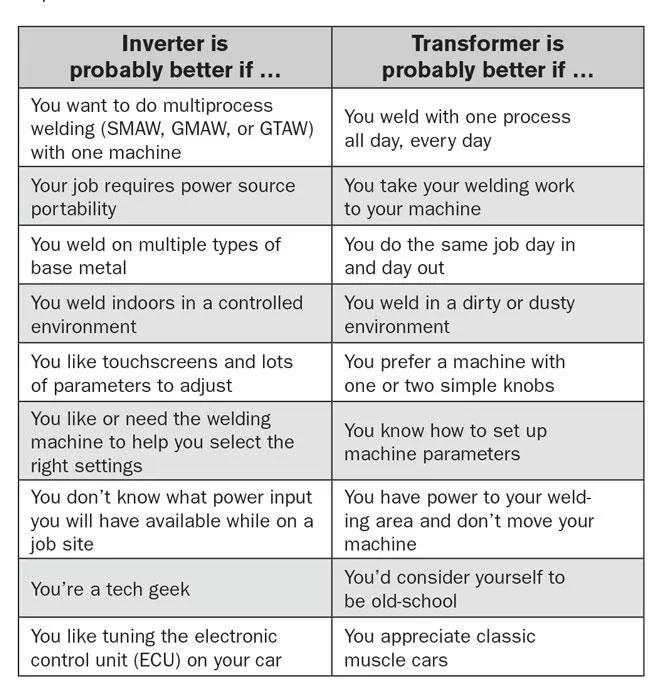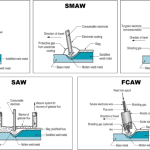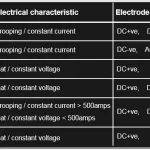Electric welding machines have been in use from the last more than a century. As with every technology, these machines are enhanced than in the previous decade. If you want to start a civil war in welding just ask a question to a group of welding experts” which is better, the inverter or the transformer machine. The short answer here can be “it depends” but the long answer here will be a lively debate about the pros, cons, and specific features and applications of the equipment.
Transformer Welder vs Inverter Welder
Welding Town
Many welding professionals have a clear choice when they have to choose between inverter and transformer welding machines. However, the choice of welders should depend on the work at hand suitable for the machine.

We are compiling here the data and essential information about welders for your better insight into how these machines work to select which one suits your needs best. Now we will discuss transformer vs inverter welder: which one is better and why.
Inverter Welder Synopsis
How does the inverter welder work?
Here the principle is to convert alternate current to a lower usable output voltage. We can convert 240V AC supply to 20V DC output by using a couple of electronic parts to transform the power from AC to lower usable DC.
The traditional transformer primarily relies on a large transformer to control the required voltage while an inverter welder can operate by increasing the power supply frequency from 50Hz up to 20,000-100,000Hz.
This is possible with the electronic buttons for power off and on fast up to one-millionth of a second. This way we can control the power supply before it enters the transformer, and the size of the transformer can be greatly reduced.
Remarkable Features
1. Superior Efficiency
The inverter welder can be planned to adjust the weld bead profile and thickness of your need. The appearance of the weld bead improves tremendously along with the best welding quality. The mechanism involved with the inverter welder is highly efficient and remains cool even with extended operation. These use minimum filler material with this technology. This mechanism offers better production and reduces heat input as well.
2. Efficient and Power Saver Welder
These inverter welding machines are not only power efficient but also back stress friendly and least cost connection. They are the perfect replacement for the conventional transformer when we consider heat generation and energy consumption.
An inverter welder has a power output of 93% as compared to transformer welding machines. The level of production with transformer welders is 60%. The inverter technology reduces the size of the transformer and the proportionate weight of the welder.
The power loss due to the magnetic core is reduced significantly with it.
3. Cooling Provision
These sophisticated inverter welders are equipped with an inner cooling fan. It helps to reduce the operating heat and prevent extra heat production. The cooling of the fan, not only reduces the extra heat production but increases the life expectancy of the machines.
4. Stability, Solidity, and Output Voltage
The traditional transformer welding machines use alternating current and appliances do not get continuous current and output power. In this situation, these types of equipment need several reignitions approximately 100-120 every second. In contrast to transformer welding machines, the inverter welder may not take a longer time to generate heat.
These welders maintain a constant low current in operation. It ceases temperature and voltage unsteadiness as they have the feature of anti-interference. This interference helps the machine to maintain lower temperature changes and voltage fluctuations.
As the transformer welder uses alternating current, the arc is not constant and burns continuously. It leads to increased heating time which leads to a reduction of the strength of the weld.
5. IGBT Technology
This type of inverter welder gains power very quickly due to its insulated gate bipolar transistor technology. This inverter welder operates at a very fast pace and consumes very little energy in the final operation.
6. Lightweight and Compact Model
Due to its simple design, the inverter welder is prevalent almost everywhere. These welders are compact as compared to transformer-type equipment. These can be stored in a smaller space very easily and proved as space-saving equipment.
The compact design with the lesser weight of the transformer makes it handy. The frequency here is much higher than needed for the running frequency.
Considerably size increases, reactor weight, and operating frequency are minimized to a great extent.
Advantages of Inverter Welder
➢ Economical in lower power consumption
➢ Best control over the electric arc
➢ Cooling fan safeguards its parts from the heat
➢ Handy and portable
➢ Compact and space saver
Disadvantages of Inverter Welder
➢ Less durable as compared to a transformer
➢ Repair and maintenance are expensive
Transformer Welder Synopsis
How does this transformer work?
These conventional welding options are workhorses of high performance and need main power. They are commonly used for industrial rod applications and are available in the range of 250A to 600A at 415V.
The transformer welding machine permits the welder to choose the output current by moving a winding core away or closer from the secondary winding, It can also shift a magnetic shunt inside and outside of the transformer core utilizing saturating reactor in a series with an alterable approach with secondary current output. It can allow the welder to choose the output voltage by tapping the secondary winding of the transformer.
The transformer-type appliances are usually cost-effective.
Differentiating Features
In transformer-type welding machines alternating current is applied which in turn leads to conversion and metal spatters increases affecting the seam’s quality.
The effectiveness of the transformer is approximately 80% of the energy used here to heat the iron of the appliance. The transformer devices are divided into households when current production is 200amperes, professional and 1/2 professional is up to 300 amperes and professional goes beyond 300 amperes.
When the appliance is used for household the electric current single phase of 220volts is utilized. The professional, industrial, and expert devices use 380 volts in the three-phase current.
1. Dependability
Reliability and dependability is the most debatable aspect of the welder. For almost 9-10 decades transformer welders are having all-inclusive studies, research, and development to generate reliable, dependable, and sturdy welding machines while inverter welders have been getting attention for the last 3 decades.
The transformers are more reliable and dependable as compared to the best inverter welders. Although this gap is decreasing speedily in the last few years. The initial nightmare with inverter welders of 1990 is gone now.
2. Potential Restrictions
As we go with the trend and find transformer welding devices as more simple but dependable, while inverter welders integrated with numerous features are less reliable.
The transform can last longer if they are kept properly for a longer period of time. They are bulky and with less advanced features as compared to the inverter welders.
Now it is up to you to decide as per your need, do you need a dependable transformer welder or advanced features added to the inverter welder. You may keep an inverter welder as a backup welder along with the dependable transformer welder.
3. Halt or Downtime
Many situations in the surrounding may lead to premature destruction of the inverter welders like high airborne pollutants with high humidity. The manufacturers are trying to develop inverter welders where these environmental calamities do not affect the inverter welder anymore.
These are more liable to failure and if your machine is not fixed your daily operations are held until it is fixed. This may hold your project and directly interfere with your income. The hobbyist is affected directly as well.
Your welding machine is crucial to the smooth functioning of your business, you need to make an assessment of the downtime of the welder that you will have. If the situation is prevalent for the environmental effects on your welder then it is better to choose a reliable and dependable choice than a versatile appliance with many functions. In these circumstances, the transformer welders are the best bet as they are durable, reliable, and do not cease often.
4. Scope of Applications and Range
Transformer welding machines are used in almost every scope of life where ferritic metal welding is needed.
➢ Used in laying and mending pipelines
➢ Plumbing and welding of pipelines
➢ Attaching metallic structures at the site of a building
➢ Can join or overlap two or more sheet materials
Advantages of Transformer Welder
➢ Low initial cost
➢ Low or minimal maintenance
➢ Low running expense
➢ Highly dependable and reliable
➢ Good for farm repair
Disadvantages of Transformer Welder
➢ Arc ignition is difficult
➢ Sensitive to voltage reduction
Which is suitable for you?
We have discussed that inverter welding machines have advantages over transformer welding machines, but these benefits may not be of any help to you. The final verdict to choose welders depends upon the user’s preferences.
We have discussed all the finer details to help you to take your requirement into account and figure out what suits you better.
Now we put together a list of differences between a transformer and inverter welders taking due consideration durability, weight, cost, and many more factors.
The following are the points for consideration here.
1. Endurance and Durability
By virtue, of the transformer having higher duty cycles, They can perform heavy-duty tasks than inverter welders. As the inverter welders are a new entry in the welding inventory so to judge durability is not feasible.
Presently we are aware of the durability of transformer-type welding machines only as they are in use in industries for quite a long time to enhance performance. One thing about the inverter technology is that it looks fascinating to pack multiple features in compact and lightweight equipment.
2. Price of the Equipment
This pricing between inverter and transformer remains a debatable subject. We find many transformer welders are budget-friendly at the initial stage.
With the longer use of inverter welders, you may save a lot of money. This cost comes down over a period of time. We find inverter welders utilize less power approximately 10% of your electricity bill.
The increased arc stability results in fewer consumables and welding gases. We can safely say that our inverter welders will pay for themselves.
3. Weight of the Machine
Inverter welders are lighter in weight as compared to transformer welding machines. They are generally half many transformer welders heavy. Suppose you are to complete your task in a larger area and an immobile task, you can make a choice of transformer welder.
In the condition of intending to move your welder around or work in a restricted space, the inverter welder is an automatic choice.
4. Strength and Effectiveness
We have observed that in the last six to seven decades transformer welding machines have traveled a great journey. The premium quality of welding machines does have an appealing efficiency quotient while maintaining a quite stable arc.
Most inverter welders are generally twice as effective as transformer welding machines. The inverter welder utilizes half the amperes as compared to the transformer welder to get similar degrees of voltage.
Most inverter welding machines can be run using ordinary house sockets and there is no need to purchase a generator or a larger 220V plugin.
The inverter welder for quite a long time using direct current. They had quite a more stable arc than ordinary DC transformer welders, and the only single option for an alternate current welding machine was available.
In recent times inverter welding machines can use both alternating and direct current in a more effective manner. and can create a more stable arc. These reasons are enough to label inverter welders as best for their strength, stability, and effectiveness.
5. Quality of the Welded Product
As we are discussing types of welding machines that will not be completed without knowing the quality of arc and weld beads. If you are a welder who works on placid steel generally then the transformer welding machine is your automatic choice.
In the welding perfection world where we reside, we need protection in every position and on every metal. Inverter welders are a shining stone in this demanding world. Inverter welders can be programmed to perform anything. We see the enhanced working of MIG and TIG inverter welding machines.
The software was once enhanced with electronics to improve the capability of the welding machine. An average welder can perform with the best results.
When innovation and weld quality is the consideration, the inverter welding machine won the race, The transformer still remains a great choice for steel.
6. Welder’s Duty Cycle
The inverter welding machine generally has a higher duty cycle due to the size of the transformer. The smaller parts of the inverter welder heat up fast but can be cooled much faster and easier by the inbuilt fan.
While traditional transformer welders, the parts are bigger and large, therefore retaining heat for a longer time and cooling down slowly.
7. Generator Power for Welding Machines
The inverter welding machines can be operated easily on small portable welding generators. The inverted welder becomes more effective with this feature which is almost impossible for the transformer welding machine to run on generators.
The danger of welding machines while running on the generators is a separate issue but kept it informed.
8. Usability & Productiveness
The performance, the usability of the inverter welder are considerably higher. This can be better illustrated with stick welding where the operator finds it easy to operate and produce the best results without a fight with the continuous stable arc.
The higher open-circuit voltages and features like arc force, anti-stick, and hot start make the inverter welder more acceptable. This can be compared with a traditional welding machine if doing the welding on slim materials, the inverter type can do the job easily.
With the inverter welder having a stable arc, and limitless amperage adjustment, the power can be reduced greatly. The sheet of 1.6 sheet metal or pipe sections can be welded with ease and in a controlled manner.
How to Define IGBT?
The IGBT stands for ” Insulated Gate Bipolar Transistors”. IGBT is a high-speed switching appliance used for all weldless welders and it makes the regulation of the voltage easy.
MOSFET transistors technology is still prevalent in some inverter welders. Although the IGBT technology is having a vast superiority over MOSFET. Most crucial is that IGBT does not fluctuate with generator power and mains fluctuations and is so less vulnerable to damage and failure.
Indications of Inverter Welder Uses
- In the regulated and controlled environment
- Can be used for numerous base metal
Indications for Transformer Welder Uses
➢ Same metal for a very long project duration
➢ Dirty and dusty environment friendly
Verdict
The last 2 decades have witnessed a rapid transformation in inverter welding machines. They are continually improving their functionality and cost as well. It does not mean that the transformer welder will be redundant as they have had their crucial place in today’s industry.
The ultimate decision goes to the user who makes a weighted decision considering numerous factors.









